A couple of good- and hopeful – things to report this week:
The ever-conscientious Environmental Court Judge Larry Potter ordered the partial reopening of Madison Avenue between Main and Second. Memphis Mayor A C Wharton said that the opening will be “soon.” He tweeted: “It should be soon. A barrier must be constructed around the 118 Madison demolition project. After that, one lane of eastbound traffic will open and the Madison Avenue trolley line will re-open.”
Progress. One lane at a time.
Meanwhile, the equally responsive, conscientious Memphis City Councilman Bill Morrison reports that MLGW will be correcting the mismatched sidewalk at Tiger Lane in the coming days.
He reported that MLGW President Jerry Collins said that his crew was given a “recipe” so the sidewalk would match, but once it dried, it was obvious that it didn’t. A work order was already under way to get it “fixed.” We were asked by MLGW to be more patient.
As of two days ago, a reader emailed that MLGW continues to block Union Avenue between Fourth and Danny Thomas. The email said the lane has been blocked for roughly three months. Hopefully, Mr. Collins can get that moved up on the priority list too. We were told by City Hall that the delay stems from a problem with the company hired to do the job. As Urbanut put it, sometimes there’s a reason they’re the low bid.
A plus to the Pyramid redevelopment is that part of it involves the removal of the Lone Star concrete silos, a long-time eyesore on the riverfront. Until then, however, someone in Shelby County Government should pay some attention to it. Sadly, this photo of the sign is out-of-date and today, lighted letters on both the south and west sides of the sign are missing letters.
The sign was installed by county government in cooperation with the Memphis Convention & Visitors Bureau, but as part of the deal, former Shelby County Mayor Jim Rout agreed that his government would pay the sign’s utilities and keep it maintained. That worked fine until former Public Works Division Director Ted Fox was not reappointed by new Mayor Mark Luttrell.
Mr. Fox was determined to keep the sign fully lighted. We’re told that the CVB has suggested to county government that if all the letters aren’t lighted up, it would be better to turn the sign off altogether.
It sounds like a good idea, because a neon M mphis sends asmessage to visitors. It’s just not the one we want.
Memo to Shelby County Government: turn off the sign.
Following up our post about Memphis’ infatuation with razor wire, John pointed us to the First Tennessee Bank razor-wired parking lot across from the downtown elementary school. It seems largely superfluous since there are various entry points to the lot for any potential thieves, while at the same time telling parents at the adjacent school they should be careful because they’re leaving their kids in one tough neighborhood. We know we’re demanding on government, but the private sector needs to develop a better-honed sense of place and urban design too.
John also directed us to the “temporary” fence that was erected at the Hickman Building on Madison Avenue near the downtown YMCA. There are a lot of these kinds of “temporary” things downtown that someone become permanent without anyone checking back on them.
Finally, we got a photo from a Germantown reader illustrating “some of TDOT’s favorite pasttimes – knocking down trees.” It’s part of the widening of Poplar through the suburban town and it “feels an awfully lot a solution in search of a problem. But such is roadbuilding in Tennessee.”

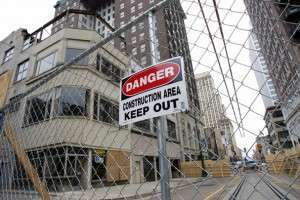
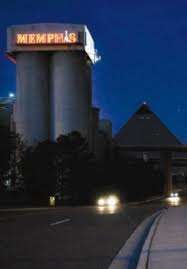
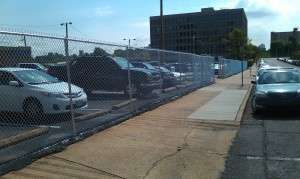
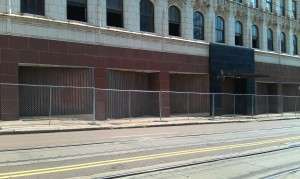
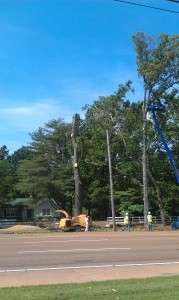


SCM-
Thank you for the updates.
I would like to think that I am an eternal optimist, however I could not help but cringe slightly when I read of Judge Potter’s order recently to reopen the eastbound lane of Madison. My “spider sense” tingles especially considering the plight of the Hickman Building a mere 3 blocks away on the same street. Hopefully this will not be a prelude to the semi-collapsed building entering into that mysterious realm of the brushed aside and forgotten or “out of sight, out of mind”.
Perhaps this new regular focus on the deficiencies in our urban context will prevent such inaction from remaining the norm.
And we really appreciate your help in identifying some of the examples to shine a light on.
On a recent trip to Nashville, I noticed that the First Tennessee logo was atop a grand downtown skyscraper. I tried, but found no chain link fence anywhere around.
On a recent trip to east Memphis, I noticed the beautifully landscaped First Tennessee offices at Oak Court. I tried, but found no chain link fence anywhere around.
I wonder where people are supposed to park in those places? It’s too bad those places won’t tolerate their front door marketing message to be designed by the same team that so adeptly secures prisons? I hope someone chuckles because my head is about to explode.
The Hickman has ridden out the wave of unprecedented residential development, the lowest interest rates in history, the highest condo prices in history, the development of a $72 million ballpark across the street, a new elementary school next door, 400 new(ish) neighbors and the introduction of the trolley. Its current owner has outlasted this and two city mayors, three county mayors and three downtown development agency administrations. During this time 20 year tax abatements, subordinating low interest loans and historic preservation tax credits have all come and gone. Granted, its across the street neighbor is in a similar state… just with the lipstick in mural form… but surely the residents, visitors and employees of this area deserve a better effort than a fence?
The Hickman Building is an especially interesting case. The building serves as a high rise neighbor to an elementary school. Aerial photographs show that the annex structure to the north of the Hickman building now lacks a roof and the interior is open to the elements. Adjacent sidewalks are blocked by chain link fences presumably in order to safeguard the public from falling debris. That in and of itself should be reason to move against such owners in court. If a building presents a risk that warrants such a barrier and closing of the public domain, then should the owners not be financially responsible for their own negligence? In this case, the same records reflect that the building is not owned by a some financial institution or some absent landlord. No, we can find that the Hickman Building is owned by a local resident located in East Memphis. I for one would be very interested to understand such an individual’s motive in purchasing such a property and facilitating its continued decay and endangerment to the public.
Seeing as a common element and practice of owners that are incapable of maintaining their properties is to simply erect a chain link fence to absolve themselves of the risks inherent in the structure, I would propose the city enact a hefty right-of-way fee be enforced where any structure requires the closing of a sidewalk or street (or any public right of way) due to negligence or lack of maintenance for the property owner’s structures. If a daily fee is assessed for these situations we might see owners take more interest in their properties. Simple maintenance would be far cheaper than the daily fee and a lack of fencing would risk a lawsuit should someone be injured by these properties.
Urban: Love the right-of-way fee! If the government has to compensate landowners for taking their property (eminent domain), then landowners should compensate the government for taking their property (chain-link fences).
Now, how to implement this strategy…
I wonder if Judge Potter could use his Environmental Court?
Anonymous 11:26 is me. Technology hates me and I hate it right back.
Tom Leatherwood’s site says the Hickman Building at 240 Madison is owned by Hickman Properties at 5478 Pecan Grove Lane in Memphis. Maybe people should look up that phone number and start calling.
Andy,
It is definitely tempting, but anything beyond neutral questions might have the opposite effect from a personal initiative standpoint.
Gwyn,
These are the “standard” steps one must take to pass a local ordinance (you may already be familiar with these steps. If so chalk it up to general information. I borrowed this information from the web):
1. Research laws governing the issue. Become familiar with the state and local laws addressing your selected issue. Information will be available from your city or county clerk and the appropriate state agencies. Local libraries and law libraries may also be useful places to conduct research. No need to create a new law when and where one already exists.
2. Find a model ordinance. You will need a model ordinance to present to the city or county council. No need to reinvent the wheel here; simply find a sample ordinance or an actual ordinance that has previously passed in another locality. It is important that the language you submit has been reviewed thoroughly by you, by experts on the issue, and, if possible, by attorneys. Born Free USA can provide model ordinances on a variety of issues and assist with wording of ordinances.
3. Reach out to allies. Developing a broad base of support will greatly increase the chances that your ordinance will be adopted. Look for support in the likely places, such as the Downtown Memphis Commission, Memphis City Schools (in this case seeing as an elementary school neighbors one of the sites mentioned), neighborhood residents, as well as neighboring business and property owners.
4. Know your opposition. It is essential to become knowledgeable about the people and entities that your proposed ordinance will affect. Identify and understand potential objections to the ordinance and be able to present well thought-out counter-arguments.
5. Introduce your proposed ordinance. Find a sympathetic council member to introduce the ordinance. Try to identify one who has introduced or supported quality of life and urban design legislation in the past, or ask your own councilperson to introduce the ordinance.
6. Start lobbying. Once you have a sponsor and a bill number for your ordinance, you should begin lobbying. Provide the city or county council members with information packets about the bill. These packets should clearly and succinctly illustrate the need for the proposed ordinance. Mobilize a group of people, including grassroots organizations and local residents, to help publicize the issue through action alerts, letters to city councilpersons, op-ed pieces, etc.
7. Attend a public hearing. Once the ordinance is introduced, a public hearing is likely. If a public hearing is scheduled, arrange for strong witnesses from diverse backgrounds to testify. Rally supporters to attend the hearing, as well.
8. Prepare for the vote. When it is time for the vote, you will want to contact your city or county councilperson via phone, fax, or mailed letter to encourage him or her to vote in favor of the ordinance. Encourage as many other residents as possible to write their representatives.
Urbanut – Thanks! This is a great list & I will definitely use it.
Is there really any interest in an ordinance concerning compensation fees for blocked sidewalks? As the list stated, it will require at least some time devoted toward exploring existing ordinances and should we be lacking such an approach, identifying precedent ordinances in order to further develop the idea. We would then need to connect to the city council and develop support for the ordinance and see that it is introduced. Seeing as we all have time constraints due to employment and general life, a team approach would be more likely to convert this idea to action on the ground.
So finding existing ordinances pertaining to the closure or blocking of sidewalks did not take as long as I thought it would. Specifically reference the requirement in Sec. 12-28-5, Sub-paragraph A “…to keep clean and open”. Follow up post to define fines and punishment. Thank goodness for the internet…
Sec. 12-28-5 – Notice to property owner to build, repair or clean.
A. Whenever it is made to appear to the city engineer, or his or her lawfully authorized representative, that there has been a failure on the part of the owner of property to build, repair, or keep clean and open for public passage any sidewalk or walkway abutting on or adjacent to such property, the city engineer, or his or her duly authorized deputy, shall give notice to such owner, or his or her duly authorized agent, of the failure of such owner to build, repair, or keep clean and open for public passage such sidewalk or walkway.
B. Such notice may be given either by personal service on the owner or his or her duly authorized agent, or by certified letter addressed to the last known place of residence of such owner, or his or her duly authorized agent, and proof of the mailing of such registered letter by the city engineer, or his or her duly authorized deputy, shall be a complete compliance with this provision.
C. In the cases of nonresident or unknown owners, a publication of the notice by one insertion in a daily newspaper published in the city shall be a complete compliance with the provisions of this section as to notice.
D. The notice in each case shall specify what is required of the owner with respect to the sidewalk. The notice shall advise the owner that unless the requirement is carried out within thirty (30) days of the date of service, mailing or publication of the notice, the necessary work will be done by the city at the expense of the owner.
(Ord. 3590 § 1(12), 9-2-86; Code 1985 § 34-156; Ord. 894 § 1, 4-6-71; Code 1967 § 36-99)
Charter reference— Authority to compel property owners to build, repair and clean sidewalks, §§ 571, 572.
Sec. 12-28-6 – Failure of property owner to comply with notice.
A. Failure to comply with the provisions of this chapter and Chapter 12-24 shall be a misdemeanor subject to punishment as provided in Section 1-24-1 of this code.
B. Further, upon the failure, refusal or neglect of any person notified to comply with the terms and orders of a notice given pursuant to Section 12-28-5, the city engineer is authorized to build, repair, and keep clean and open for public passage any sidewalk or walkway abutting on or adjacent to the property of the person owning or controlling it. The cost of such work shall be a lien on such property, and may be enforced by suit in any court of competent jurisdiction.
C. As an additional and cumulative remedy, the city engineer may certify to the city treasurer the cost of such work. It shall be the duty of the city treasurer to place the amount so certified on the bill for city taxes assessed against the property abutting on or adjacent to the sidewalk or walkway laid. It shall be the duty of the city treasurer to collect, as a special tax, the amount so certified, which is declared to be a special improvement tax on the property abutting on, or adjacent to, such sidewalks or walkways. This special tax may be collected in the same manner as other general taxes are collected by the city.
What is “punishment as provided in Section 1-24-1” you might ask? This might be our problem, it amounts to little more than a financial slap on the wrist:
Sec. 1-24-1 – General penalty—Continuing violations.
A. Whenever in this Code or in any ordinance of the city any act is prohibited or is made or declared to be unlawful or an offense or a misdemeanor, or wherever in such code or ordinance the doing of any act is required or the failure to do any act is declared to be unlawful, and no specific penalty is provided therefor, the violation of any such provision of this Code or any such ordinance shall be punished by a fine of not more than fifty dollars ($50.00) for each separate violation; provided, however, that the infliction of a fine under the provisions of this Code or of any ordinance of the city shall not prevent the revocation of any permit or license for violation of any provisions hereof where called for or permitted under the provisions of this Code or of any ordinance. The city judges shall fix the amount of any fine to be levied under the provisions hereof as his or her discretion may dictate. Each day that any violation of this Code or of any ordinance continues shall constitute a separate offense.
B. Where any act of the General Assembly of the state provides for a greater minimum penalty than one dollar ($1.00), the minimum fine or penalty prescribed by the state law shall prevail, and be assessed by the city judges.
C.1. In addition to the provisions of subsections A and B of this section, and any court costs established by any city ordinance or state statute, the city is authorized to create and collect penalties, pursuant to T.C.A. Section 6-54-306, and in conformance therewith, to set a schedule specifying code section violation and penalty amount, and instituting a general penalty fund from which moneys may be disbursed.
2. The city comptroller shall be authorized to disburse allocations from the general penalty fund budget annually as approved by the council for implementing and maintaining programs as may be instituted for correction of ordinance violation. Each day constituting a separate offense and fine as set out in subsection A of this section, shall also be constituted as a corresponding separate penalty.
3. Penalties may be waived at the discretion of the judge; however, unless waived, penalties shall be assessed in the amount set out below:
Each code section violation for which a fine has been imposed, shall automatically carry a penalty of up to two hundred dollars ($200.00), except the following designated sections shall carry a minimum penalty of two hundred dollars ($200.00): This sections does not include blocking a sidewalk, thus I am assuming that the fine is capped at $50 as mentioned in section A.
With all that in mind, I will cirlce back to my original psot this morning- who wants to create a more severe penalty for blocking a public sidewalk due to negligence on the part of property owners?